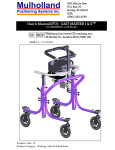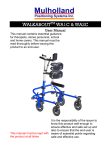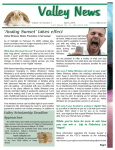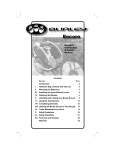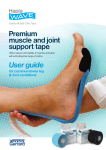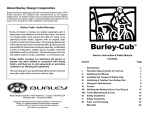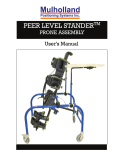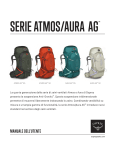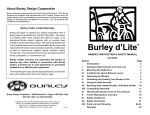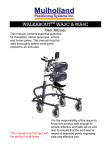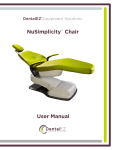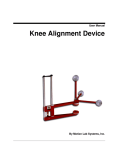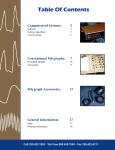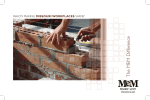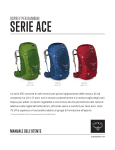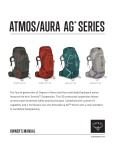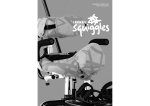Download User Manual
Transcript
ROCKET STANDER 1 & 2 Use r s Manual 1 TABLE OF CONTENTS 2 Preface 3 Design Goals 3 Precautions 3 Components 4 Assembly 5-8 Adjustment Overview 9 Fitting Instructions 10 Main Column Adjustment 10-11 Tray Adjustment 12 Knee Block Adjustment 13 Foot Support Adjustment 14 Folding the Stander 15 Optional Configurations 16-21 Supine Stander 16-17 Neckrest Support System (Prone) 18-19 Shoulder Pad Assembly 20-21 Placing the Child in the Stander 22 Maintenance 22 Technical Data 23 PREFACE This instruction manual provides information to professionals for the set up and use of the Rocket Stander. Supported standing can stimulate headrighting, weight-bearing on the forearms, and mid-line hand use. Standing also provides an opportunity for peer socialization and upper extremity activities, which should be an integral part of a standing program. DESIGN GOALS The Rocket Stander was designed to provide individuals requiring prone, vertical, or supine standing, precise postural control at the upper trunk, pelvis, knees, and ankles. Adjustment from prone to vertical to supine offers therapists the opportunity to provide graduated weight-bearing to promote more normal tone distribution and stability, and selective extension of the spine. PRECAUTIONS 1. Standing should always be prescribed by the child s physician with recommendations for duration of standing, frequency and contraindications. The standing program should be closely monitored by the child s therapist. 2. The stander should be used under direct adult supervision at all times. 3. Do not use for transportation. 4. Use stander only on level surfaces. 5. Observe load limits on product label. 3 COMPONENTS Refer to figure 1. 1. 2. 3. 4. 5. 6. Sternum Pad Tray Assembly Main Column Tilt Trigger Locking Castors Tilt Bar 7. Shoe/Foot Supports 8. Folding Strap 9. Knee Support 10.Upper Column 11.Hip Support 12.Trunk Support 1 2 12 11 3 10 4 9 8 5 7 Figure 1 4 6 ASSEMBLY Tools Required: 5/32 , 3/16 , 1/4 allen wrenches (included in the pouch) Tape measure Adjustment Levers: Refer to figure 2. The adjustment levers can be ratcheted so the handle can rotate without affecting the tightness of the screw. 1. Pull up lever to disengage. 2. Rotate the handle so it is not obstructed. 3. Release and let the handle slide back and lock with the screw. 4. Continue tightening/loosening the screw by rotating the handle and repeating steps 1-3 as needed. Figure 2 Ball Lock Pins: Refer to figure 3. 1. Hold the head of the pin between your index and middle finger. 2. Press in on the blue button with your thumb while extracting (or inserting) the pin. Figure 3 1 Hand Knobs: Refer to figure 4. 1. Release (unlock) the knob by turning it counter-clockwise. 2. Lock the knob by turning it clockwise. Figure 4 5 Step A: Prepare for Assembly Refer to figure 5. Lay the components out on the floor. You should have received the following for a basic system: 1. Base 2. Upper Column 3. Tray 4. Two Knee Supports 5. Foot Support Figure 5 C2 Figure 7 Step B: Assembly the Base Refer to figures 6 & 7. 1. Pull up on the main column until the tilt mechanism slides in between the black markings. 2. Tighten the two allen screws that secure the tilt bar to the main column. 3. Swing the legs away from each other Figure 6 until they lock into place. Note: The main column is correctly aligned if it is vertical when the base is standing on the floor. 6 Figure 7 C1 Step C: Insert the Upper Column Refer to figure 8 1. Remove the allen screw from the bottom part of the upper column. 2. Slide the upper column down into the main column. 3. Line up the holes in the upper and main columns (1), and tighten the adjustment lever to secure. 4. Insert the allen screw (1) and tighten. 2 1 Figure 8 Step D: Attaching the Knee Blocks and Foot Supports Refer to figure 9. 1. Slide the Knee Blocks into their respective brackets and secure with the adjustment levers. The vertical adjustment levers should be facing outward. 2. Slide the foot supports onto the bottom of the column, and secure by tightening the two allen screws (1). 1 Figure 9 7 Step E: Attaching the tray Refer to figure 10. 1. Release the hand knobs (1) on the ends of the tray mounting bar. 2. Place the tray assembly on the tray mounting bar so the teeth on the angle locks (2) mesh. 3. Lock the cams to secure the tray by turning the hand knobs (1) clockwise until tight. 8 Figure 10 2 1 ADJUSTMENT OVERVIEW The separate and combined adjustments are critical to the effectiveness of the Rocket Stander. The therapist is encouraged to try various adjustment combinations to find the optimal position for weight-bearing, tonal balance, and head-righting. It is further recommended that an on-going adjustment schedule be identified to meet the needs of physical growth, reduction, or increase in postural support and weight-bearing activities. Adjustments: 1. Column Tilt (Pitch): Affects the child s orientation in space, postural tone and distribution of weight. After the column tilt adjustment has been made, always replace the ball lock pin, so as to not accidentally release the trigger. 2. Hip and Trunk Support: Provide not only lateral, but also anterior/posterior support. The hip support should always be snug. The trunk support can be graded to allow for lateral movement as the child acquires increased trunk control. 3. Knee Supports: Knee blocks provide not only anterior support, but can also change in angle to accommodate flexion at the knees. 4. Foot Supports: The foot supports are independently adjustable to provide equal weight bearing through both lower extremities. They can be adjusted to compensate for leg length discrepancy, plantarflexion/dorsiflexion, rotation, and hip abduction. 5. Tray Height: Tray height adjustment can provide an upper extremities weightbearing surface (for table top activities) and can also assist in head control (by stabilizing the shoulder girdle through forearm support). The tray is pitch adjustable and reversible for supine standing. See the following pages for specific adjustments and fitting instructions. 9 FITTING INSTRUCTIONS Measurements: The following measurements are required for proper fitting: 1. Heel to the iliac crest (hip bone): _______ This will be the distance from the footplates to the top of the hip support on the stander. 2. Heel to axilla (under arm): _______ The distance from the footplates to the top of the trunk support on the stander. 3. Heel to the lowest point on the patella (knee cap): _______ The distance from the footplates to the middle of the knee block. 4. Hip width (widest part): _______ The exact width of the hip support. 5. Trunk width: _______ Usually the exact trunk support width, but may be looser if the child has good trunk control. 6. Leg length discrepancy: _______ The distance the individual foot support must be lowered on the longer side. MAIN COLUMN ADJUSTMENT Refer to figure 11. For measurements see Fitting Instructions. Note: Never make any adjustments with the child in the stander. 1. Keep the hip support (A) as close to the frame pivot point as possible. This is extremely important! This is done by loosening the 4 allen screws and sliding the hip support next to the frame junction support. Retighten the screws. 2. Measure from the top of the hip support to the foot supports, then loosening the 2 screws, lower or raise the foot support to the correct height. Retighten the screws. 3. Measure from the foot supports to the middle of the knee block (C). Adjust the knee blocks to the correct height. Retighten the screws. 4. Measure from the foot supports to the top of the trunk support (D) and adjust the height. If more height is required, loosen the adjustment lever (F) and extend the column. Retighten the screws. 5. Very lightly loosen the 4 screws on the trunk support (to not disturb the 10 height adjustment), and adjust the width. Tighten firmly. Repeat for the hip support. 6. Pitch: remove the ball lock pin (E) on the trigger tilt by pushing in on the black button as you pull out. Squeeze the trigger to adjust the pitch of your column. Replace the ball lock pin! 7. Adjust the knee block angle. 8. Adjust the angle of the foot supports. Remember that if the hips and knees are flexed to 10 degrees, the foot supports must be plantarflexed 10 degrees to give neutral alignment at the ankles. This is very important for children with limited range. Figure 11 11 TRAY ADJUSTMENT Refer to figure 12. 1. Height: Loosen the two allen screws (1) and slide the tray along the upper column to the desired height. Tighten the screws. 2. Depth: Loosen the two knobs (2), located underneath the tray. Slide the tray along the tray bar to the desired depth. Tighten the knobs. 3. Angle: Release both hand knobs (3). Rotate the tray about the tray mounting bar to the desired angle. Make sure the teeth on the angle locks mesh. Tighten the hand knobs. Figure 12 1 3 12 2 KNEE BLOCK ADJUSTMENT Refer to figure 13. 1. Angle: Loosen the adjustment lever (1). Rotate the knee support bar (2) until the knee pad is at the appropriate angle to support the knees. Tighten the lever. Repeat for both sides. 2. Depth: Loosen the adjustment lever (1). Slide the knee support bar until the knee pad is at the correct width to assist in the alignment of the lower extremities. Tighten the lever. Repeat for both sides. 3. Height: Loosen adjustment lever (3). Slide the knee pad along the knee support bar to make small height adjustments. Tighten the lever. Repeat for both sides. 4. For additional height adjustment: Loosen levers (1) and rotate the knee support bar 180°. Tighten the lever. Loosen lever (3), then remove the knee blocks and replace them right side up. Slide the knee blocks to the desired position then tighten the levers. 5. Width: Loosen the two allen screws (4). Slide the knee block along the knee block bar (5) to the desired width. Tighten the screws. Repeat for both sides. Figure 13 3 4 2 5 1 13 FOOT SUPPORT ADJUSTMENT Refer to figure 14. 1. Leg length discrepancy: Loosen the allen screw (1), the outer screw on the mounting bracket, for the shoe holder which needs to be lowered. Lower the shoe holder, by lowering the shoe holder support bar (2), to accommodate the lower leg. Tighten the screw. 2. Abduction: Loosen the screws (3), located on the footrest mounting brackets underneath the shoe holders. Adjust the width between the shoe holders by sliding them along the footrest bars (4). Note: Excessive abduction may cause increased weight-bearing on the medial borders of the feet. Tighten the screws. 3. Plantarflexion/Dorsiflexion: Loosen the screws (3). Rotate the shoe holders about the footrest bar. Tighten the screws. 4. Rotation: Loosen both flat head screws (5) on the top of the shoe holder. Pivot the shoe holder about the rear flat head screw. Tighten the screws. Repeat for both shoe holders. 5. Depth: Loosen the allen screw (6). Slide the foot support along the support bar. Tighten the screw. Repeat for both shoe holders. Figure 14 1 5 6 2 4 3 14 FOLDING THE STANDER Refer to figures 15 & 16. 1. Tilt the stander column, by removing the ball lock pin first then squeezing the trigger, until the column is vertical. 2. Remove or lower the tray. 3. With one hand, hold on to the top of the column and tilt the stander up on to the front wheels (1). With your other hand, squeeze the frame lock pins (2), and tilting the frame forward, allow the back frame to swing to the front frame. Secure with the strap (3). Figure 15 2 1 Figure 16 3 15 OPTIONAL CONFIGURATIONS Always remove the child from the stander before alterations are made. Supine Stander Convert to supine: Figure 22 1. Replace the sternum pad with the supine neckrest assembly (refer to figures 23-25): a) Loosen the adjustment lever (1). Slide the sternum pad assembly off the upper column. b) Attach the supine neckrest by sliding the track stud (2) into the front track of the upper column. c) Tighten the adjustment lever (3), on the neckrest assembly, to secure the neckrest. The track stud must be completely within the front track. d) Adjust the height of the neckrest: Loosen the adjustment lever (3). Slide the assembly along the upper column to the desired height. Tighten the lever. e) Adjust the depth of the neckrest: Loosen the two allen screws (4). Slide the neckrest back/forth to the desired depth. Tighten both 4 2 3 1 Figure 23 16 Figure 24 Figure 25 screws. 2. Move the tray (refer to figures 26): a) Release both hand knobs (1) then lift the tray off the tray mounting bar. 1 b) Replace the tray on the opposite side of the upper column. c) Retighten the hand knobs to lock the tray in place. d) The tray must be removed to place the child in the supine stander. 3. Move the foot supports (refer to figure 27): c) Loosen the four allen screws (6). Slide the foot supports off the footrest bars. d) Rotate the foot supports to face the opposite direction. e) Replace the foot supports on the footrest bars. f) Tighten the four allen screws to secure the foot supports. Figure 26 6 6 Figure 27 17 Neckrest Support System (Prone): Attaching the prone neckrest support system: Refer to figure 28 & 29. 1. Remove the upper column: a) Unscrew the safety screw from the column (see Step E in the assembly instructions for details). b) Loosen the adjustment lever on the main column. c) Slide the upper column up and out of the main column. 2. Add the neckrest support system: a) Loosen the two allen screws (1), located on the side of the neckrest bar clamp. b) Slide the neckrest bar clamps onto the main column. c) Tighten the two screws. 3. Replace the upper column: a) Slide the upper column back into the main column. b) Tighten the adjustment lever on the main column. 1 Figure 29 18 Figure 28 Adjustments: Refer to figure 30. 5 3 1. Neckrest assembly height: a) Loosen the two allen screws (figure 29.1). b) Slide the neckrest bar clamps along the 4 main column to the desired height. c) Tighten the screws. 2. Neckrest assembly depth: a) Adjustment lever (2), located at the bottom of the neckrest post. b) Slide the neckrest support to the desired location. c) Tighten the adjustment lever. 3. Height of the neckrest: a) Loosen the two allen screws (3), on the 2 side of the ear clamp. b) Slide the neckrest along the hex bar (4) to Figure 30 the desired height. c) Tighten the screws. 4. Depth of the neckrest: a) Loosen the two allen screws (3). b) Slide the neckrest ears (5) back/forth to the desired depth. c) Tighten the screws. 5. The neckrest support system can be moved out of the way while placing the child in or removing the child from the stander. Loosen adjustment lever (2) and slide the neckrest support out of the way. Reverse procedure to return post to vertical position. 19 Shoulder Pad Assembly: Attaching the shoulder pad assembly. Refer to figure 31. 1. Remove the neckrest from the neckrest bar (1): Loosen the two allen screws (2) on the ear clamp. Slide the neckrest off the neckrest bar. 2. Add the shoulder pad assembly: Loosen the allen screw (3) located on the side of the cross bar bracket (4). Slide the cross bar bracket onto the neckrest bar. Tighten the allen screw. 3. Replace the neckrest: Slide the neckrest onto the neckrest bar by placing the neckrest bar between the ear clamps. Tighten the two 2 allen screws (2). Adjustments: Refer to figure 31 & 32 20 1. Height: Loosen the allen screw (3). Slide the cross bar bracket along the neckrest bar to the desired height. Tighten the screw. 2. Depth: Loosen the bar clamp (5) by loosening the allen screw (6) 3 on the top. Loosen the lock pin block (7) by loosening the allen screw (8) on the side. Slide the shoulder pad back/forth to the depth which provides the appropriate amount of anterior support. Align the lock pin block, with the plunger pin (9) on top so the shoulder pad will lock in position when in use and when pivoted out of the way. Tighten the allen screw (8) to secure the lock pin block. Slide the bar clamp against the pivot pin receiver (10) to provide enough tension to lock the pivot. Tighten 1 4 2 Figure 31 7 10 5 3 12 8 6 11 Figure 32 the allen screw (6) to tighten the bar clamp. Repeat for both sides. 3. Width: Loosen the set screw (11) on the bottom of the pivot pin receiver. Slide the receiver along the hex bar (12) to the desired width. Tighten the set screw. Repeat for both sides. 4. Pivoting the shoulder pads: The shoulder pads can be released and pivoted out of the way while placing the child in or removing the child from the stander. Pull the ring on the back of the plunger pin to release the pivot. To open, rotate the shoulder pad away from the column until the pivot locks. Repeat for both sides. To replace, pull the ring and rotate the shoulder pad in the opposite direction until the pivot locks. 21 PLACING THE CHILD IN THE STANDER 1. Always lock the casters on the stander before putting the child into it. 2. The child s therapist should identify whether one or two people are required to transfer the child to the stander. 3. Place the child s feet into the shoe holders and slowly lift him into standing. 4. Fasten the hip strap (velcro) first, then the trunk strap (velcro). 5. Check for proper alignment and weight bearing. 6. Fasten the buckle straps on the hip and trunk supports, the buckle straps for the shoe holder, and the velcro straps on the knee supports. 7. The child should be under direct adult supervision at all times. 8. Provide a table top or socialization activity while the child is standing. 9. Observe the child closely for signs of fatigue, distress, or discomfort. 10.Remove the child within the prescribed time period. MAINTENANCE 1. Keep the stander clean. The metal and plastic parts can be washed with a mild concentration of dish soap (the same as you use on your dishes). Rinse with water and dry. Wipe down all of the upholstered parts with a damp cloth. 2. Check weekly for frayed straps and velcro, which may need replacement. For the child s safety, discontinue use of the stander until worn velcro and straps are replaced. 22 TECHNICAL DATA Specifications: Rocket 1 Rocket 2 Weight Limit: Height Range: Length: Width: Frame Color: 50 lbs (23 kg) 24-41 (61-104 cm) 26 (66 cm) 22 (56 cm) Corvel Red (Morton 40-4023) Black 75 lbs (34 kg) 36-50 (91-127 cm) 32 (81 cm) 22 (56cm) Corvel Red (Morton 40-4023) Black Upholstery Color: Materials: Frame: Parts: Padding: Fabric: Castors: Drive Wheels: Powder-coated aluminum tube Black anodized aluminum extrusion Stainless steel tube Powder-coated aluminum Black anodized aluminum Black ABS plastic, flame retardant Clear Plexiglas acrylic Neoprene foam Nylon packcloth Naugahyde (US393) Solid gray cushion rubber with delrin bearing Grey pneumatic tire on nylon rims with double seal ball bearings 23 839 Albion Ave P.O. Box 70 Burley, ID 83318 Phone: (208) 878-3840 (800) 543-4769 Fax: (208) 878-3841 [email protected] www.mulhollandinc.com 24
























